Review of the Aquarius well pump: design, characteristics, connection and operation rules
The construction of an independent water supply system with water intake from an underground source dictates the need to purchase pumping equipment. Out of habit, we look for products from foreign companies for furnishing. However, the Aquarius well pump is not inferior in reliability and performance to units of foreign brands. It costs much less. And this is a significant plus, don’t you agree?
Do you want to understand the design features of the Aquarius pump? Here you will find answers to all your questions. The information offered for consideration will help you choose the right pump unit correctly and will familiarize you with the specifics of operation and maintenance of the device.
To make your choice easier, we have described in detail the range of deep-well pumps with the Aquarius logo. The rules were given and the sequence of connecting to an autonomous water supply and electrical network was thoroughly discussed. Photos and video attachments accompanying the article will help you better understand the topic.
The content of the article:
- Aquarius is an excellent choice for a country well
- Features of the deep-well pump device
- Operating principle of the submersible apparatus
- Purpose and characteristics of models
- Selecting a model based on specific characteristics
- Rules and procedure for connecting the pump
- Possible malfunctions and methods for eliminating them
- Conclusions and useful video on the topic
Aquarius is an excellent choice for a country well
The unit, easy to use and install, is produced by the Promelektro company (Kharkov, Ukraine).In addition to submersible pumps, the company produces drainage and surface pumping equipment, electric motors, and feed grinders.
A series of pumps for deep use includes products used in wells installed “on sand” and “on limestone”. The range of distances from water intake to its supply to the surface is from 20 to 200 m.
The most powerful models can serve a large cottage or 2-3 country houses, as their productivity reaches 12 m³/h.
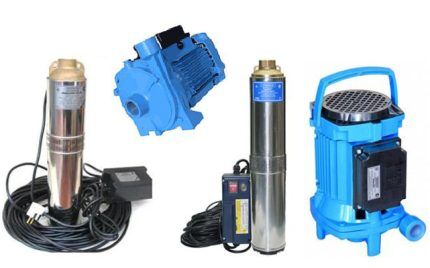
Among the advantages of the Aquarius line of devices are:
- economical energy consumption;
- high productivity;
- low noise figure;
- wear resistance of parts made of stainless steel, brass and food-safe plastic;
- possibility of warranty or self-repair;
- light weight and dimensions corresponding to the diameter of the well;
- complete set allowing you to begin installation immediately.
Don't forget about IEC 335-1 (international safety standard), warranty service for one and a half years and the ability to need for repairs purchase spare parts from the manufacturer.
In terms of technical characteristics, the modifications are comparable to foreign analogues PEDROLLO and GRUNDFOS. Cost depending on the model – from 1800 rubles. up to 27,400 rub.
Features of the deep-well pump device
All downhole submersible models Aquarius have a similar structure.
The main parts are:
- multi-stage pumping sector;
- electric motor separated by a filter;
- capacitor box located outside.
Hidden under the body is a pumping unit - a monolithic box with rotating impellers and a drive.
It is the dimensions of the impeller that are responsible for one of the main characteristics of the unit - productivity. The larger its diameter, the larger the portion of water supplied over a certain period of time.
All parts are securely fastened with a screw-threaded lid. It is also the place where the cable is fixed, one of the pump mounting elements inside the well.
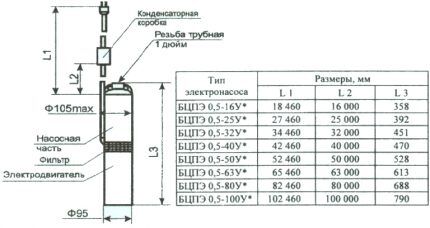
The motor, using a rotor-stator combination and bearings, drives the apparatus. It is filled with oil. The capacitors and electrical cable are enclosed in a condensation box.
To ensure that the equipment does not fail under force majeure circumstances, for example, during rapid drying, automatic protection made in Germany is provided.
Operation monitoring and control is carried out using a remote device. Knowledge of the structure of the Aquarius pump will help with its repair.
Operating principle of the submersible apparatus
To supply water upward and move it the required distance, it is necessary to create pressure. The centrifugal type of pump produces the required pressure by rotating a wheel (or several wheels), which is mounted on a working rod (shaft) and connected to the engine.
When the wheel starts, kinetic energy arises and is transferred to the blades, and from them to the liquid. As a result, water is scattered towards the walls, then moves from the receiver to the adjacent (upper) chamber, and in its place, under pressure, another portion of water from the well arrives.
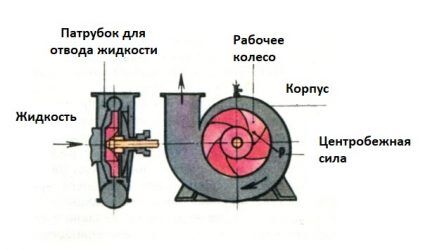
A suction pipe is designed to collect liquid, and a filter is provided to protect the internal parts of the device from clogging and rapid wear. The device is simple, but so effective that there is no point in looking for a device with a different operating principle.
All elements of the mechanism are placed in a fairly compact elongated “sleeve”, the design of which is ideal for lowering into a narrow wellbore.
Unlike vibrating analogues, centrifugal ones work evenly and carefully, due to which they do not lift sand from the bottom and do not destroy the walls of the well.
Purpose and characteristics of models
To reach a larger audience, the Promelektro company produces models of various modifications. For convenient orientation, some parameters of the units are included in their names.
For example, let’s take the position of BTsPE 0.5-100U 60/150 and decipher the digital data:
- BCPE – household centrifugal submersible electric pump;
- 0.5 (l/s) – productivity;
- 100 (m) – nominal pressure at nominal volumetric flow;
- 60 (l/m) – maximum productivity;
- 150 (m) – the height of water rise in the well at the highest pressure.
In accordance with individual requirements, you can choose a device belonging to one of four groups: 0.32 l/s, 0.5 l/s, 1.2 l/s, 1.6 l/s.
Let's assume you own a well or small well (diameter 100 mm, 120 mm and above) with limited flow rate. Most likely, water consumption does not exceed 2 m3/h. Obviously, the choice should fall on the BCPE-0.32 model.

Models with a productivity of 0.32 are quite popular, since many people visit the dacha irregularly, and the number of permanent residents rarely exceeds 3-4.
If you decide to purchase a device with minimum performance, please note that other indicators may differ (for example, pressure parameters). This series consists of 9 models.
The next series - BTsPE 0.5 - has a total of 8 models, differing in pressure (from 16 m to 100 m). The pumps can operate with both manual and automatic control. The devices are equipped with a protective function that protects against overheating.
If the diameter of your well is at least 110 mm and the flow rate is from 2 m³/h, you can choose one of the models in this series. The device can also be useful for other purposes, for example, if there is a need to pump out water from a pool, pond or natural body of water.
Pumping equipment with a capacity of 0.5 l/s is perfect for watering lawns, beds, flower beds or garden plantings.
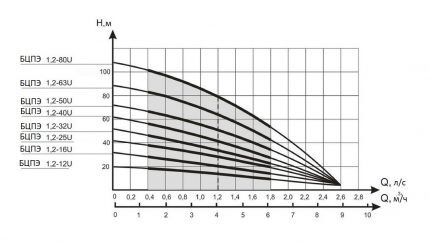
The next series - with a capacity of 1.2 l/s - includes a line of 8 products that differ in pressure (from 12 m to 80 m). The manufacturer warns that hot water (with a temperature above +35 ºС) cannot be pumped, as well as overly contaminated liquid.
The most productive are the BTsEP 1.6 models, which are presented in three modifications - with a head of 25 m, 32 m, 40 m. In their line, they also differ in design - they have a different number of pumping stages, from 6 to 8.
Taking into account the technical characteristics of the Aquarius pump, you can choose a unit according to your individual requirements.
Selecting a model based on specific characteristics
Let's consider all the stages of choosing a brand pump. These recommendations are general in nature; you can find more detailed information in the technical data sheet and installation instructions.
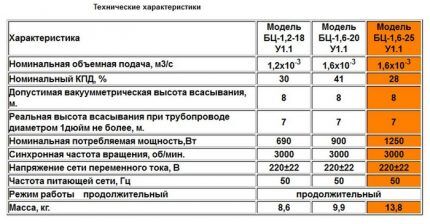
Before purchasing, it is important to consider all the characteristics necessary to make the right choice.
Namely:
- well diameter;
- well flow rate;
- water levels in the well (static and dynamic);
- estimated water consumption;
- distance from source to home;
- pressure in the hydraulic accumulator (damper tank).
The diameter of the well is very easy to determine - it is indicated in the technical passport, which is issued by the company that drills and installs equipment. Most likely, the diameter is standard, that is, it has dimensions of 100 mm, 133 mm, 152 mm. Aquarius pumps are best installed in wells with a cross-section of more than 100 mm.
The flow rate is also indicated in the passport, thanks to this parameter it is easy to select a pump based on performance. It is important that the pump parameters do not exceed the figures specified in the documents.
Let's assume that the flow rate of the source is 3 m³/h. This is a fairly low figure, which means that there is no need to purchase models from the BTsPE 1.2 series (or higher performance), BTsPE 0.5 is sufficient.
When operating more powerful equipment, the volume of water in the source will not have time to recover, drying will occur and the device will automatically turn off.
The water level must be known in order to correctly determine the installation depth of the pump. Usually the distance to the water surface and from the surface to the bottom is indicated in the passport, but you need to remember a couple of nuances.
The first concerns the installation features of a submersible pump - it is lowered 4-5 m below the surface. The second concerns the variability of the water level.
During the warm period, the level usually decreases, and the difference with the initial value can be up to 4-5 m. It turns out that for installation you need to know the minimum level.
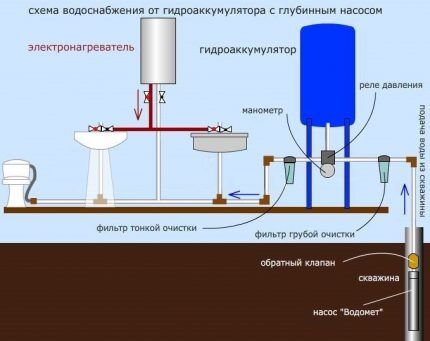
To calculate the total water consumption, several factors must be taken into account:
- number of permanent residents;
- number of points of use inside the house (bathroom, kitchen, shower);
- the presence of distribution points outside the house (watering the garden, a tap in the summer kitchen, a tap in the bathhouse), etc.
On average, if you do not take into account additional facilities, the daily consumption per person is 200 liters.
The distance between the water source and the house is necessary to calculate the additional load on the pump. Standard calculation: 10 m of horizontally laid pipes equals 1 m of vertically laid pipes (both – 0.1 atmosphere).
The pressure of the damper tank affects the shutdown threshold. Let’s assume that if you have a volumetric tank of 300 liters installed, then to turn it off you need a pressure of 3.5 atmospheres (converted to vertical meters - 35).
Rules and procedure for connecting the pump
In order for Aquarius brand pumping equipment to work properly, it is important to install and connect it correctly using the appropriate components.
Purchase of components for installation in a well
In addition to purchasing a pump that comes with an electrical cable and a rope for hanging, you may need to purchase the following equipment:
- Hydraulic accumulator with a set of adapters. Enough for a small family (2-3 people) small hydraulic accumulator volume 100 l: the larger the volume, the less often the device will turn off).
- Heading. Purpose well head - cover the shaft from street debris and precipitation, serves as a place for attaching pipes.
- Pipe from pump to tank. Required for outdoor use, 32mm or 40mm diameter.
- Adapter from pipe to submersible pump. For an Aquarius pump and a pipe with a diameter of 32 mm, a type 1’ product with an outer cut of 32 mm is suitable.
- Steel cable with clamps. If for some reason you are not satisfied with the product supplied in the kit.
- Submarine cable. Used for electrical cables.
Together with the hydraulic accumulator and pump, purchase pressure switch and a pressure gauge. Equipment made in Germany and Italy has proven itself to be excellent.
For example, if the tank volume is more than 300 l (8 atm.), the MDR 5-8 Grundfos relay model is suitable.

Preparing and installing the pressure pipeline
To have problems with delivery of water from a well there was less in the house, the pipeline must have certain qualities.
Namely:
- tightness;
- strength;
- minimum length;
- no bends.
Twists and bends can cause air pockets to form, impeding the movement of water. The shorter the pipes, the fewer connecting elements are needed: fittings, couplings, flanges.It is not recommended to use a threaded connection. A possible product option is HDPE-32 pipe.

Check valve installation
The check valve is not included with the pump, but its presence in the water supply system at home is necessary. The main purpose of the valve is to block the movement of water in the opposite direction.
This means that during the work check valve is open and allows liquid to move freely towards the disassembly points. However, when the pump is turned off, it shuts off the water, preventing it from moving back.
The valve is installed directly at the outlet of the well pump. It is mounted in a pipe above the pump, in some cases at a short distance from it (no more than 1 m).
When installing the valve, pay attention to the arrow indicating the direction of water movement. This is necessary so as not to embed the part with the back side.

Fastening equipment on a cable
A nylon cable for mounting the pump is included in the kit, but some users note that over time the elastic material loses its elasticity and stretches.
To prevent deformation, you can use a stainless steel cable. It is threaded through special holes in the upper part of the pump housing and firmly tied.
Along with the cable, it is necessary to lower the electrical cable into the well.To prevent mechanical damage and additional load on it, you should make a kind of bundle of safety rope, pipe and electrical cable.
We fasten the cord not in a stretch, but in a loop, with small allowances. It is prohibited to lift the pump from the well by the electric cable.
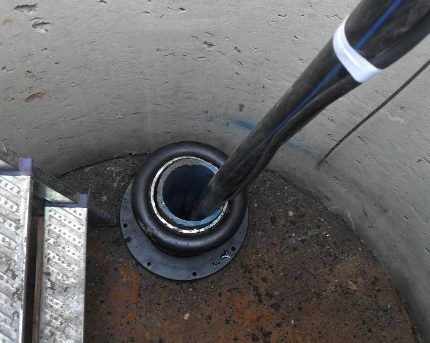
We carefully lower the interconnected communications into the casing to a pre-calculated depth. Under no circumstances should the pump touch the bottom.
Power Connection and Testing
Remember that the operation of the Aquarius pump is possible only if the voltage parameters are observed - 220 V. With other indicators, the normal functioning of the equipment is not guaranteed. If the network specifications do not meet the manufacturer's requirements, connect Voltage regulator.
After immersing the pump in the well, make sure that its body is completely submerged in water. The power cord should not be taut like a string. Only after checking the fulfilled conditions, proceed to connecting the Aquarius pump to the power source.
If the device began pumping water and turned off only when the automation was triggered, everything was done correctly.
To ensure uninterrupted operation of the equipment, preventive disassembly is carried out. If deficiencies are noticed after inspection, they must be eliminated. For example, you can replace the bearings (if the running is tight), change the oil, check the motor winding.
You may also find information about how to replace the old pump with a new one, set out in our other article.
Possible malfunctions and methods for eliminating them
Despite prevention, cases of breakdown are possible, so we will consider the most common of them.
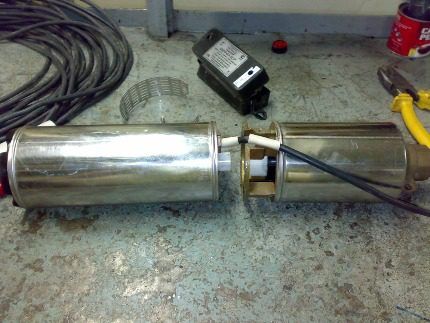
If the pump does not turn on, perform the following actions:
- check the presence of contacts in the socket;
- inspect the pump for clogging with sand;
- We measure the voltage, if there is a deficiency, we connect a stabilizer.
If productivity suddenly decreases, we check whether there is a leak in the pipeline. At the same time, we inspect and clean the filters. When the voltage decreases, we use a stabilizer.
The pump will sooner or later become clogged with sand, so we clean it: remove the mesh and protective chute, separate the pump part and the electric motor, check the operation of the shaft, and wash all the elements. We assemble the device in reverse order.
Conclusions and useful video on the topic
How to make calculations to correctly select an Aquarius pump:
Technical characteristics and capabilities of the Aquarius BCPE 1.6 40u model:
How to repair the Aquarius device (1/3):
How to disassemble and clean the Aquarius pump with your own hands:
Sequence of installation and connection of the unit:
As you can see, the Aquarius pump is an easy to install and maintain, effective device for supplying water in an autonomous water supply system.
Regular independent inspections and minor repairs will help extend its life, but if you have difficulties installing or choosing a new model, use the services of professionals.
Do you use an Aquarius brand pump to deliver water to your home from a well? Or are you just planning to purchase it and trying to find out more about the company’s equipment? Or maybe you encountered a certain breakdown and were able to fix it yourself? Please write about this in the comments below - your experience will help another Aquarius owner.




I’m thinking of buying such a pump for the dacha; I think it’s a big advantage that it won’t be difficult to buy spare parts for it. My neighbor at the dacha has already purchased it and has been using it for more than six months without any problems, and overall he was pleased with the purchase. But he advised me to definitely buy a voltage stabilizer, he said that pumps of this kind are very sensitive to changes.
Well done author, useful article.
Good afternoon, in your article it is written that the check valve should be installed immediately after the pump, or no more than a meter from the pump. And the pump passport says at least 5 meters from the pump. So which is better?
I agree with the question. The instructions say: 5 meters from the pump, install a check valve. Can it be installed directly on the pump?
Hello. Let’s not reinvent the wheel; on the official website for Aquarius brand pumps, the following recommendations are given:
«The check valve can be installed directly into the pump discharge pipe or embedded into the pressure pipe, at a distance of up to 1 meter from the pump outlet pipe. It is possible to install a check valve on the surface only in cases where the Aquarius pump is immersed in close proximity to the surface of the earth (up to 3 meters); in all other cases, use the above recommendations.In any case, we recommend choosing a check valve with a brass seat«.
In general, the issue is controversial; quite a few copies have been broken on the forums, where to put approx. We describe this device in great detail in this article.
"Aquarius" 160-80 served for 8 years. Used all year round. 50 acres under drip irrigation in summer and winter 300 liters per day for keeping animals. In June 2018 it failed - the upper part with a set of plastic impellers was worn out as a result of the pump running dry, i.e. without water. Purely my mistake.
The idea of the Aquarius pump itself is excellent. But the big minus is that it was “damaged in Ukraine.” After a while, depending on your luck, the plastic with which the upper flange of the pump is filled decomposes. And it contains threads for sealing the electrical wire, for attaching the motor to the pump. It's better to avoid this pump. Or twist it with stainless wire. As always.
Good afternoon. I installed a BTsPE-2-30-0.37 pump at the dacha for irrigation in a 16-meter well. But the pump power is too high. Five minutes and the well is empty. Is it possible to somehow regulate the power by connecting, for example, a pump through a powerful dimer?